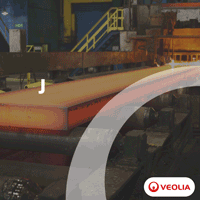Upgrades to ThyssenKrupp Hot Strip Mill Pass Acceptance Test
02/02/2016 - ThyssenKrupp Steel Europe AG has signed off on upgrades to the intensive cooling section at a hot strip mill in Germany.
According to project vendor Primetals Technologies, the improvements to the No. 2 hot strip mill at ThyssenKrupp’s Duisburg-Beeckerwerth facility are intended to foster development of new materials that require higher cooling rates.
“ThyssenKrupp Steel Europe now runs its hot strip mill to produce materials that could only previously be made on plate rolling mills, and uses the intensive cooling system with great success for many grades that used to be cooled only in laminar mode,” Primetals said in a statement.
“The high cooling rates and precise temperature control allow exact adjustment of the microstructure. Consequently, smaller quantities of alloying elements are needed to produce certain steel products.”
Primetals installed and commissioned the mill’s original Power Cooling system in 2010. When it went into service, it had 16 cooling headers above the roller runout table and another 16 below. It covered an 8-meter section of the table.
With the upgrades, the system now has 32 headers above and 32 below, covering an 18.5 meter section of the table, Primetals said. In intensive mode, the height-adjustable headers can provide around 6,200 cubic meters of cooling water per hour at a pressure of about three bar.
“Four booster pumps, each rated at 375 kilowatts, feed the cooling system. They can raise the laminar pressure to a maximum of three bar to achieve the full water flow rate. The capacity of the associated water management system was increased to a continuous output of 9,000 cubic meters per hour,” Primetals said.
The project was completed in five months and has passed its acceptance test, Primetals said.
“ThyssenKrupp Steel Europe now runs its hot strip mill to produce materials that could only previously be made on plate rolling mills, and uses the intensive cooling system with great success for many grades that used to be cooled only in laminar mode,” Primetals said in a statement.
“The high cooling rates and precise temperature control allow exact adjustment of the microstructure. Consequently, smaller quantities of alloying elements are needed to produce certain steel products.”
Primetals installed and commissioned the mill’s original Power Cooling system in 2010. When it went into service, it had 16 cooling headers above the roller runout table and another 16 below. It covered an 8-meter section of the table.
With the upgrades, the system now has 32 headers above and 32 below, covering an 18.5 meter section of the table, Primetals said. In intensive mode, the height-adjustable headers can provide around 6,200 cubic meters of cooling water per hour at a pressure of about three bar.
“Four booster pumps, each rated at 375 kilowatts, feed the cooling system. They can raise the laminar pressure to a maximum of three bar to achieve the full water flow rate. The capacity of the associated water management system was increased to a continuous output of 9,000 cubic meters per hour,” Primetals said.
The project was completed in five months and has passed its acceptance test, Primetals said.



-(220-x-200-px)-(130-x-130-px)-(220-x-200-px).jpg?lang=en-US&ext=.jpg)
.gif?width=200&height=200&mediaprotectionhash=ddb07947ad3b4ab959a83714461eccd5c6895f370695eb035a9ff7aa736f8ad9&ext=.gif)





